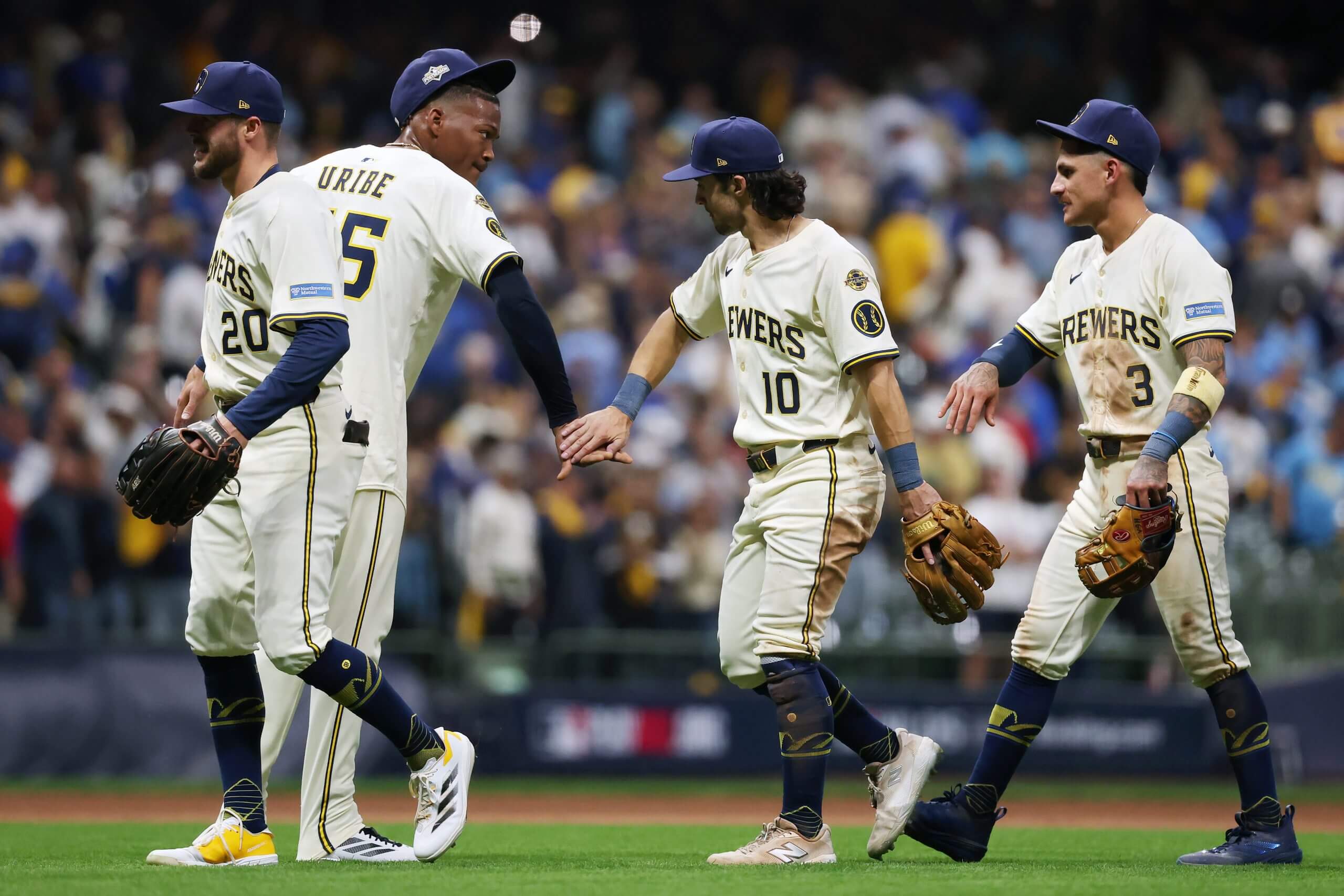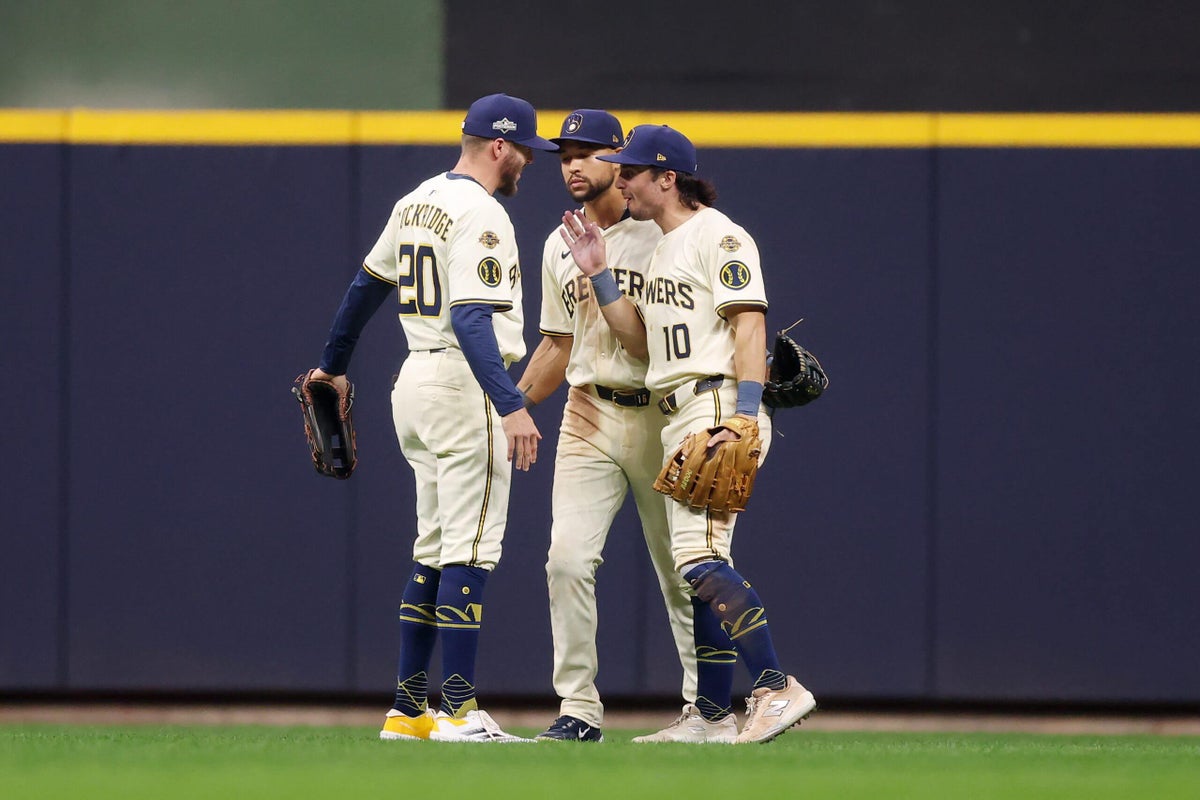CHICAGO — Inside the delirium of a division-clinching celebration at Busch Stadium, Milwaukee Brewers outfielder Sal Frelick found general manager Matt Arnold and pulled him into an embrace. These sorts of scenes bring teams together: players spraying knock-off champagne, executives crushing Miller Light tall boys.
There was just one problem. Arnold stands about 6-foot-2. Frelick is listed at 5-foot-8. Which meant that when they hugged, Frelick extinguished a cigar on his boss’s neck.
Watching nearby, reliever Abner Uribe commemorated the calamity.
“No extension!” Uribe said. “No extension!”
Frelick, of course, is the sort of player the Brewers would be happy to secure to a long-term agreement. He fits the organizational profile for a team looking to sweep the Chicago Cubs in Game 3 of the National League Division Series on Wednesday. Frelick won a Gold Glove in right field last year. He put up a career-best .756 OPS this year. And he is, to put it charitably, not particularly tall.
The average big-league hitter in 2025 registered at 72.3 inches, just north of 6 feet, according to Elias. With the exception of Christian Yelich, the 6-3 face of the franchise, no Brewers regular exceeds that standard. Among the players, the lack of height does not go unnoticed, especially when watching Frelick, catcher William Contreras (5-10), first baseman Andrew Vaughn (5-10), shortstop Joey Ortiz (5-10), outfielder Isaac Collins (5-8) and third baseman Caleb Durbin (5-7) exit the diamond.
“There are times where we sit on the bench and you look out after they’re running in off the field, and you’re like, ‘Man, we’re tiny,’” veteran pitcher Brandon Woodruff said. “We’re fielding a team that’s tiny. But man, these dudes, it’s just a different brand of baseball.”

The Brewers may be undersized, but they’ve outscored the Cubs 16-6 so far in the NLDS. (Michael Reaves / Getty Images)
In both a figurative and a literal sense, the Brewers raced to the best record in 2025 by playing small ball. The lineup scored the third-most runs in the sport despite ranking 22nd in home runs. Milwaukee designed its offense to badger opponents. The group does not strike out much (fifth-lowest rate in the majors) and puts the ball in play without chasing (sixth-best walk rate). The hitters use their legs with swiftness and aggression; no team was worth more runs on the bases, according to FanGraphs.
The approach places the other team in a nine-inning blender. The group presumes every extra base is there for the taking.
“We force them,” Frelick said, “to throw us out.”
In turn, the Brewers induced more errors than any other club in 2025. They make routine plays more difficult, as the Cubs discovered when reliable second baseman Nico Hoerner flubbed a grounder in the first inning of a Game 1 rout.
“They say control the controllables — you can’t control the height,” said second baseman Brice Turang, who, at 5-11, qualifies as a veritable skyscraper in Milwaukee’s infield. “We’re just trying to maximize what we’ve got.”
The diminutiveness fits the ethos expressed by manager Pat Murphy, who has spent the year insisting that the Brewers, winners of the National League Central in four of the past five seasons, are underdogs.
But the organization is not wedded to the concept of smaller fielders. When the Brewers reached the National League Championship Series in 2018, the infield featured notable heft: catcher Erik Kratz (6-foot-4, 250 pounds), first baseman Jesús Aguilar (6-foot-3, 277), second baseman Jonathan Villar (6-foot-0, 233), shortstop Jonathan Schoop (6-foot-1, 247) and third baseman Mike Moustakas (6-foot-0, 230). They called themselves the “Big Boy Infield,” and printed up T-shirts.
That same summer, Milwaukee selected Turang, a slender prep infielder from California, with the 21st pick in the draft. Three years later, the Brewers used the No. 15 pick on Frelick, a compact former high school quarterback, out of Boston College. The two became 25-year-old cornerstones in 2025. Turang bulked up to where he could contribute 18 homers. Frelick hit .288 with 12 homers.
Despite his pedigree, Frelick finds himself defined more by his stature than his skills. “My boys always make fun of me,” Frelick said. “If somebody is talking about me, it’s always like, ‘Oh, he’s scrappy.’ Or, ‘ball player.’ And they’re always like, ‘Dude, it’s so funny how no one ever says, ‘Talented.’”
It is easy to overlook the undersized.
Milwaukee searches the depths of every market in player acquisition. Sometimes the available athletes come with perceived flaws, like a lack of height. The Brewers cannot afford to ignore them. Because the benefit of a seemingly insignificant move can be immense, as the club learned after selecting Collins in the minor-league portion of the Rule 5 draft in 2022. After two more seasons in the minors, Collins emerged as a National League Rookie of the Year candidate in 2025, with a .779 OPS in 130 games.
“He’s a huge part of this year,” Murphy said. “One of the most underrated guys on the club.”
Murphy learned the appeal of unconventional players during his decades recruiting as a college coach at Notre Dame and Arizona State. As he often does, he supplied a metaphor: “Back in the day, you had this pack of Lifesavers,” Murphy said. “You opened it up, everybody grabbed the red one. But the orange ones weren’t too bad.”
The red Lifesavers — the best prep prospects in the country — were unlikely to ever matriculate to campus. “A lot of times the orange Lifesaver, or the kid who’s going to come to college, is shorter or has thick ankles, something like that, a chubby kid,” Murphy said. “But they can play baseball.”
For Murphy, this theory’s apotheosis was Dustin Pedroia. Before Pedroia became an American League MVP and two-time World Series champion for the Boston Red Sox, he was a shortstop at Arizona State, listed at 5-foot-9. Recalled Murphy, “I used to tell Pedroia: ‘Your height is to your advantage. If the ball goes through your legs, it’ll hit you in the cup.’”

Brewers manager Pat Murphy knows first-hand from his time as a college coach the value in an undersized player. (Michael Reaves / Getty Images)
A couple years ago, Murphy visited the Arizona Fall League to watch some prospects. He found himself smitten with Durbin, then a stocky infielder in the New York Yankees organization. “I’m like, ‘Look at that little s—,’” Murphy said. “I just loved the way he played.”
“He’s on a mission to relentlessly pursue growth,” Murphy said. “You can’t stop him.”
Durbin stood about 5-foot-5 as a freshman at Lake Forest High in the Chicago suburbs. He graduated with four varsity letters in wrestling, three letters in baseball and two additional inches in height. “I’ve always been the smallest guy on the field,” he said.
Unable to generate interest from Division I schools, he played at Division III Washington University in St. Louis. After batting nearly .400 in college, Durbin was taken by the Atlanta Braves in the 14th round of the 2021 draft. The Yankees acquired him after the 2022 season. When the Brewers dealt away closer Devin Williams after last season, the primary return looked like pitcher Nestor Cortes. But Milwaukee viewed Durbin, the second piece in the deal, as a crucial part of the package.
Durbin made his big-league debut on April 18 and never left. Unwilling to duck out of the box when pitchers threw inside, he led the National League after getting hit by pitches 24 times. His peskiness extended a lineup that finished the regular season tied with the Dodgers for seeing the fifth most pitches per plate appearance. These are some of the, ahem, little things that helped Milwaukee rank third in runs in 2025.
“We just have a team with a lot of smaller guys who are perceived to be less talented but more hard-working,” Durbin said. “We’re definitely a hard-working group of guys. But we have a good skillset, that’s maybe less valued, but it plays at a high level.”
In a Game 1 trouncing of the Cubs, the Brewers stuck to the script, scoring nine runs without any homers. Two days later, the lineup flashed its potential by swatting three home runs in another laugher. Milwaukee is now one victory away from another champagne bash. The team would likely be an underdog when matched up with the Los Angeles Dodgers or Philadelphia Phillies. The hitters will certainly be shorter.
“We’d rather be ‘scrappy’ than an All-Star lineup,” Frelick said. “It feels better that way.”

